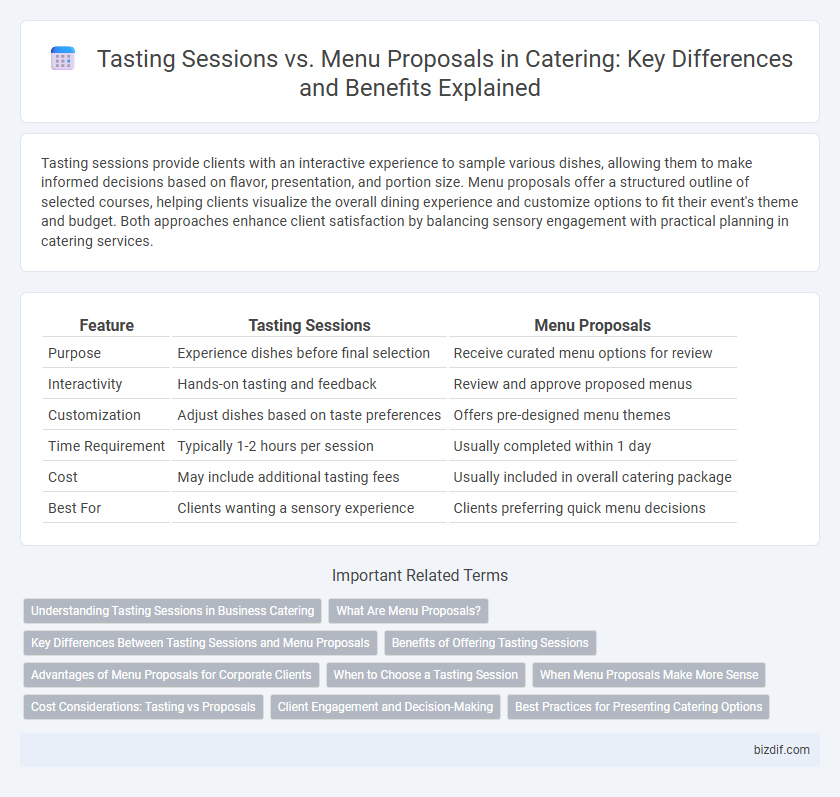Tasting sessions provide clients with an interactive experience to sample various dishes, allowing them to make informed decisions based on flavor, presentation, and portion size. Menu proposals offer a structured outline of selected courses, helping clients visualize the overall dining experience and customize options to fit their event's theme and budget. Both approaches enhance client satisfaction by balancing sensory engagement with practical planning in catering services.
Table of Comparison
| Feature | Tasting Sessions | Menu Proposals |
|---|---|---|
| Purpose | Experience dishes before final selection | Receive curated menu options for review |
| Interactivity | Hands-on tasting and feedback | Review and approve proposed menus |
| Customization | Adjust dishes based on taste preferences | Offers pre-designed menu themes |
| Time Requirement | Typically 1-2 hours per session | Usually completed within 1 day |
| Cost | May include additional tasting fees | Usually included in overall catering package |
| Best For | Clients wanting a sensory experience | Clients preferring quick menu decisions |
Understanding Tasting Sessions in Business Catering
Tasting sessions in business catering provide clients with a hands-on experience to evaluate dish quality, flavors, and presentation before finalizing menu selections. These sessions enable tailored menu proposals that align with corporate event themes, dietary restrictions, and client preferences, minimizing the risk of dissatisfaction. Understanding tasting sessions enhances personalized service and ensures seamless event execution through informed client decision-making.
What Are Menu Proposals?
Menu proposals in catering are curated selections of dishes presented to clients for review before finalizing an event menu. These proposals showcase a range of culinary options, including appetizers, entrees, and desserts, tailored to the event's theme and dietary preferences. Offering detailed descriptions and ingredient lists, menu proposals help clients envision the dining experience and make informed decisions.
Key Differences Between Tasting Sessions and Menu Proposals
Tasting sessions offer clients a hands-on experience to sample and evaluate individual dishes, providing direct feedback and customization opportunities before finalizing the menu. Menu proposals present a curated list of dishes with detailed descriptions and pricing, serving as a structured plan for event catering without immediate tasting. The key difference lies in engagement: tasting sessions prioritize sensory evaluation and personalization, while menu proposals focus on information presentation and decision-making efficiency.
Benefits of Offering Tasting Sessions
Offering tasting sessions allows clients to experience a diverse range of flavors and dishes firsthand, ensuring menu selections align perfectly with their preferences and event theme. These sessions enhance client satisfaction by providing an interactive platform to customize and refine menu options based on direct feedback. Tasting experiences also build trust and confidence in the caterer's culinary expertise, increasing the likelihood of securing bookings.
Advantages of Menu Proposals for Corporate Clients
Menu proposals offer corporate clients a tailored selection of dishes that align with their event theme, dietary preferences, and budget, ensuring a cohesive and professional culinary experience. Unlike tasting sessions, menu proposals save time and streamline decision-making by providing clear, curated options without the need for multiple samplings. This approach enhances efficiency in event planning and guarantees satisfaction through carefully crafted menus designed to impress diverse corporate guests.
When to Choose a Tasting Session
Choosing a tasting session is ideal when clients need to experience the actual flavors, textures, and presentation of dishes before finalizing their catering menu. It is particularly important for events with unique dietary requirements, customized menus, or high-profile occasions where the sensory experience determines satisfaction. Tasting sessions provide direct feedback opportunities, ensuring the selected menu aligns perfectly with client preferences and event themes.
When Menu Proposals Make More Sense
Menu proposals make more sense when clients require a comprehensive overview of dishes that align with dietary preferences, event themes, and budget constraints. They provide a structured framework for decision-making by highlighting ingredient sourcing, presentation styles, and portion sizes without the need for immediate tasting. This approach streamlines event planning, especially for large-scale catering orders or clients with fixed menus.
Cost Considerations: Tasting vs Proposals
Tasting sessions involve upfront costs for sample preparation, chef time, and ingredient sourcing, which can increase the initial budget but provide valuable insight into flavor and presentation. Menu proposals, while generally less costly upfront as they rely on conceptual planning, may result in unforeseen expenses if adjustments are needed after client feedback or event execution. Balancing tasting sessions with thorough menu proposals helps optimize catering budgets by minimizing costly last-minute changes and ensuring client satisfaction.
Client Engagement and Decision-Making
Tasting sessions enhance client engagement by providing a sensory experience that allows clients to sample dishes and offer immediate feedback, facilitating more informed decision-making. Menu proposals present curated options based on client preferences but lack the interactive element that tasting sessions provide, which can result in less certainty about choices. Combining both methods leads to a more personalized catering experience, increasing client satisfaction and confidence in the final menu selection.
Best Practices for Presenting Catering Options
Tasting sessions provide clients with a sensory experience, allowing them to sample proposed dishes and evaluate flavors, textures, and presentation before finalizing their catering menu. Menu proposals should be clear, detailed, and visually appealing, highlighting ingredient quality, customization options, and portion sizes to help clients make informed decisions. Combining tasting sessions with well-structured menu proposals enhances client satisfaction and streamlines the selection process for catering events.
Tasting Sessions vs Menu Proposals Infographic

 bizdif.com
bizdif.com